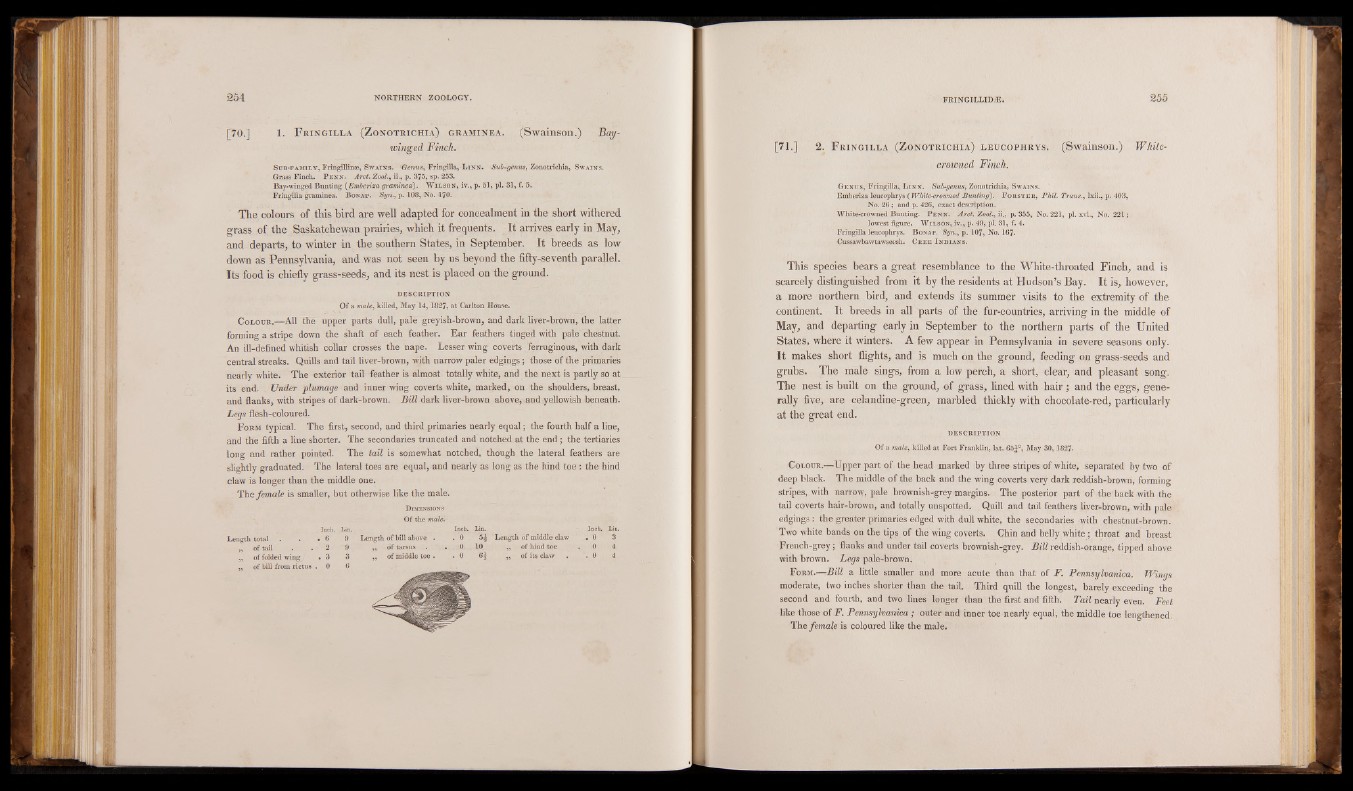
[70.] 1. F r in g il l a (Z o n o t r ic h ia ) g r a m in e a . (Swainson.) Baywinged
Finch.
S u b -f a m i l y , FrifigiHinae, S w a in s . *Genus, Fringilla, L i n n . Sub-genus, Zonotrichia, S w a in s .
Grass Finch. P e n n . Arct. Zool., ii., p. 375, sp. 253.
Bay-winged Bunting (Emberiza graminea). W il s o n , iv., p. 51, pi. 31, f. 5.
Fringilla graminea. B o n a p . Syn., p. 108, No. 170.
The colours of this bird are well adapted for concealment in the short withered
grass of the Saskatchewan prairies, which it frequents. It arrives early in May,
and departs, to winter in the southern States, in September. It breeds as low
down as Pennsylvania, and was not seen by us beyond the fifty-seventh parallel.
Its food is chiefly grass-seeds, and its nest is placed on the ground.
DESCRIPTION
Of a male, killed, May 14, 1827, at Carlton House.
C olour.—All the upper parts dull, pale greyish-brown, and dark liver-brown, the latter
forming a stripe down the shaft of each feather. Ear feathers tinged with pale chestnut.
An ill-defined whitish collar crosses the nape. Lesser wing coverts ferruginous, with dark
central streaks. Quills and tail liver-brown, with narrow paler edgings; those of the primaries
nearly white. The exterior tail feather is almost totally white, and the next is partly so at
its end. Under plumage and inner wing coverts white, marked, on the shoulders, breast,
and flanks, with stripes of dark-brown. Bill dark liver-brown above, and yellowish beneath.
Legs flesh-coloured.
F orm typical. The first, second, and third primaries nearly equal; the fourth half a line,
and the fifth a line shorter. The secondaries truncated and notched at the end; the tertiaries
long and rather pointed. The tail is somewhat notched, though the lateral feathers are
slightly graduated. The lateral toes are equal, and nearly as long as the hind toe : the hind
claw is longer than the middle one.
The female is smaller, but otherwise like the male.
D im en sio n s
Of the male.
Inch. Lin
. 0 3 'jjf Tail - . 2 9 ,, of tarsus . . 0 10 „ of hind toe , 0 4
,, of folded wing . 3 3 ,, of middle toe . . 0 H ,, of its claw . 0 4
Length total . • . 6 9 Length of bill above . . 0 5£ Length of middle claw
[71.] 2. F r in g il l a (Z o n o t r ic h ia ) l e u c o p h r y s , (Swainson.) Whitecrowned
Finch.
G e n u s , Fringilla, L i n n . Sub-genus, Zonotrichia, S w a in s .
Emberiza leucophrys ( White-crowned, Bunting). F o b s t e r , Phil. Trans., lxii., p. 403,
No. 26 ; and p. 426, exact description.
White-crowned Bunting. P e n n . Aret. Zool., ii., p. 355, No. 221, pi. xvi., No. 221 ;
lo w e st fig u re . W i l s o n , iv ., p . 4 9 , p i. 3 1 , f. 4.
Fringilla leucophrys. B o n a p . Syn., p. 107, No. 167«
C u ssaw baw taw seesk. C n e e I n d ia n s .
This species bears a great resemblance to the White-throated Finch, and is
scarcely distinguished from it by the residents at Hudson’s Bay. It is, however,
a more northern bird, and extends its summer visits to the extremity of the
continent. It breeds in all parts of the fur-oountries, arriving in the middle of
May, and departing early in September to the northern parts of the United
States, where it winters. A few appear in Pennsylvania in severe seasons only.
It makes short flights, and is much on the ground, feeding on grass-seeds and
grubs. The male sings, from a low perch, a short, clear, and pleasant song.
The nest is built on the ground, of grass, fined with hair ; and the eggs, generally
five, are celandine-green, marbled thickly with chocolate-red, particularly
at the great end.
DESCRIPTION
Of a male, killed at Fort Franklin, lat. 65j°, May 30, 1827.
C olour.—Upper part of the head marked by three stripes of white, separated by two of
deep black. The middle of the back and the wing coverts very dark reddish-brown, forming
stripes, with narrow, pale brownish-grey margins. The posterior part of the back with the
tail coverts hair-brown, and totally unspotted. Quill and tail feathers liver-brown, with pale
edgings : the greater primaries edged with dull white, the secondaries with chestnut-brown.
Two white bands on the tips of the wing coverts. Chin and belly white; throat and breast
French-grey; flanks and under tail coverts brownish-grey. Bill reddish-orange, tipped above
with brown. Legs pale-brown.
F orm.—•Bill a little smaller and more acute than that of F. Pennsylvania. Wings
moderate, two inches shorter than the tail. Third quill the longest, barely exceeding the
second and fourth, and two lines longer than the first and fifth. Tail nearly even. Feet
like those of F. Pennsylvania ; outer and inner toe nearly equal, the middle toe lengthened.
The female is coloured like the male.